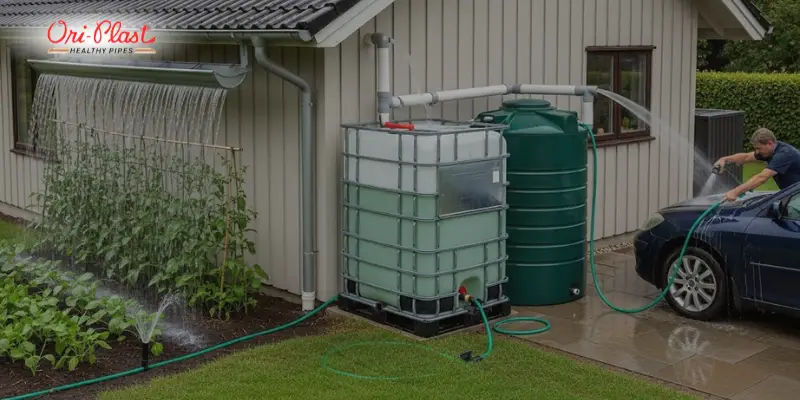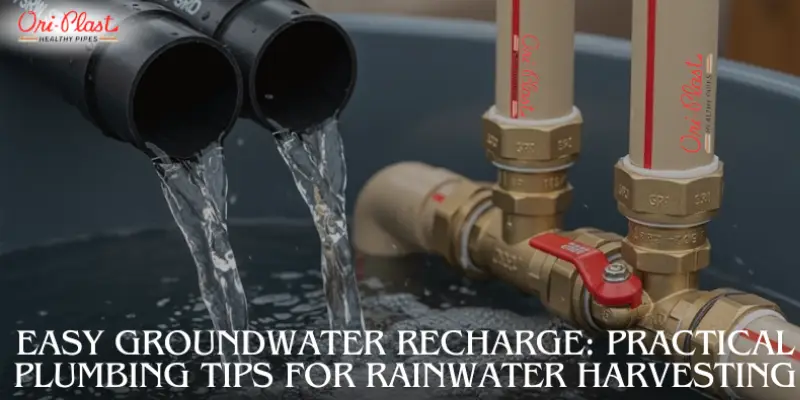With the monsoon season approaching, the arrival of rain offers a much-needed respite for millions grappling with water scarcity. Yet, for those struggling with dried borewells, the challenge of water scarcity lingers far beyond the rainy season. Groundwater depletion is a mounting concern, and traditional sources are proving increasingly unreliable. Fortunately, with a well-designed rainwater harvesting plumbing system, homeowners can efficiently recharge their borewells and support long-term water security.
In this comprehensive guide, we’ll explore the essentials of rainwater harvesting plumbing, provide practical tips for reviving dried borewells, and discuss how quality piping solutions, such as those from Ori-Plast, can make your system durable, leak-proof, and effective.
What Is Rainwater Harvesting Plumbing?
Rainwater harvesting plumbing refers to the network of pipes, filters, and connectors that channel rainwater from collection points—like rooftops—through filtration and into storage or recharge systems. This infrastructure is the backbone of any successful rainwater harvesting setup, ensuring:
- Efficient water flow
- Minimal water losses
- Protection from contamination
Using reliable, corrosion-resistant pipes like HDPE and uPVC pipes from Ori-Plast ensures long-lasting performance and peace of mind.
Why Invest in Rainwater Harvesting Plumbing?
A well-planned rainwater harvesting plumbing system offers several benefits:
- Reduces dependence on municipal water supplies
- Mitigates groundwater depletion
- Provides a sustainable, eco-friendly water source
- Prevents flooding and soil erosion
- Lowers water bills and supports off-grid living
Ori-Plast pipes provide the strength and durability required for such systems, whether for urban homes, rural setups, or institutional buildings.
Key Components of a Rainwater Plumbing System

A robust system involves several essential parts, each playing a specific role in collecting, filtering, and storing rainwater.
1. Catchment Area
The surface (usually a rooftop) where rainwater is collected. It can be made of RCC, galvanized iron, tiles, or even open ground.
2. Gutters and Downpipes
Gutters run along the roof edge, channeling water toward downpipes. Downpipes (often PVC or HDPE) direct water from gutters to the storage or recharge system. Proper support and slope are vital for efficient drainage and to prevent sagging.
3. First Flush Diverter
Diverts the first flow of rainwater that often contains dust, debris, and rooftop contaminants. Prevents pollutants from entering the storage or recharge pit.
4. Filtration Units
Essential for purifying rainwater before it enters storage or the ground. Common filters include sand, gravel, charcoal, or commercial cartridge filters. Multi-stage filters ensure the removal of sediments, debris, and pathogens.
5. Storage Tanks and Recharge Structures
Tanks can be above ground, underground, or partially buried, made from RCC, masonry, or plastic. Recharge pits, trenches, or wells allow filtered rainwater to percolate into the soil, replenishing groundwater.
6. Plumbing Pipes and Fittings
High-quality, corrosion-resistant pipes (such as Ori-Plast HDPE or uPVC) are crucial for leak-proof, long-lasting performance. Properly sized pipes ensure efficient flow and prevent blockages or overflows.
Step-by-Step Guide: Setting Up a Rainwater Harvesting System for Borewell Recharge

Step 1: Collect Rainwater from Rooftops
Install sloped gutters around the rooftop to guide rainwater into downpipes. Ensure gutters are fitted with mesh to block leaves and debris.
Step 2: Install a First Flush Diverter
This device diverts the initial, potentially contaminated rainwater away from the main system. Regularly clean and maintain the diverter for optimal performance.
Step 3: Filter the Water
Use a multi-layer filter (sand, gravel, charcoal) or a commercial filter unit. Place filters before the water enters the storage tank or recharge pit to ensure only clean water proceeds.
Step 4: Direct Water to a Recharge Pit
Design a percolation pit close to the dried borewell, but not directly connected. Use durable, leak-proof Ori-Plast HDPE pipes to route water from the filter to the recharge pit. The pit should be filled with layers of gravel and sand to aid percolation.
Step 5: Monitor and Maintain
Regularly inspect and clean filters, gutters, and pipes. Check for leaks, blockages, or overflow issues. Disinfect storage tanks periodically to prevent microbial growth.
Why HDPE and uPVC Pipes Are Ideal for Rainwater Harvesting
Choosing the right piping material is critical. Here’s why Ori-Plast HDPE and uPVC pipes and fittings stand out:
- Corrosion Resistance – No rust or degradation, even underground or in the open
- Leak-Proof Joints – Modern fittings ensure tight seals
- Strength and Flexibility – Withstand soil pressure and heavy flow
- Eco-Friendly – Non-toxic, recyclable materials
- Low Maintenance – Smooth interiors reduce blockages and ease cleaning
Ori-Plast’s ISO 14001:2015-certified pipes are used across India in domestic and commercial rainwater harvesting applications.
Practical Plumbing Tips for Effective Rainwater Harvesting
- Plan the system layout carefully to use the shortest, most direct pipe routes
- Ensure pipes and gutters have a proper slope for gravity-assisted flow
- Use quality fittings like connectors, elbows, and diverters to avoid leaks
- Install overflow outlets in tanks and pits to handle excess rainwater
- Separate potable and non-potable lines clearly if used indoors
- Install backflow prevention devices where the system connects to the municipal supply
- Ensure filters, gutters, and oriplast water storage tanks are thoroughly cleaned before and after every monsoon season.
Common Mistakes to Avoid
- Neglecting the first flush diverter can allow contaminants to enter the rainwater harvesting system.
- Using low-quality or incompatible pipes that may crack or leak
- Poor layout or insufficient slope leading to water stagnation
- No provision for overflow, risking damage to property
- Neglecting routine cleaning and maintenance
Additional Uses for Harvesting Plumbing

A well-designed rainwater harvesting plumbing system can also supply water for:
- Garden and landscape irrigation
- Car washing
- Toilet flushing
- Laundry
- Emergency use after proper treatment
By integrating rainwater harvesting plumbing into your home, you reduce your dependence on municipal supply and contribute to sustainable water management.
Conclusion:
Reviving a dried borewell or securing your home’s water future doesn’t require expensive drilling or complex technology. Sometimes, the solution lies in harnessing the rain that nature provides. With a thoughtfully designed rainwater harvesting plumbing system, you can recharge groundwater, reduce water bills, and promote ecological balance.
Choose quality piping solutions like Ori-Plast HDPE and uPVC pipes for a leak-proof, durable, and maintenance-free system. With certifications such as ISO 14001:2015 and products approved by the Bhutan Standards Bureau, Ori-Plast brings unmatched quality and performance to every installation.
Whether you’re setting up a new rainwater harvesting system or upgrading an old one, Ori-Plast ensures reliability and peace of mind.
Frequently Asked Questions (FAQs)
1. What is rainwater harvesting plumbing, and why is it important?
Rainwater harvesting plumbing is the system of pipes, filters, and fittings used to collect and channel rainwater from catchment areas like rooftops into storage tanks or recharge pits. It helps reduce dependency on municipal water, supports groundwater recharge, and promotes sustainable water use.
2. Can rainwater harvesting really help recharge a dried borewell?
Yes, if designed correctly, rainwater harvesting systems can effectively recharge dried or low-yield borewells. Directing filtered rainwater into a nearby percolation pit helps gradually recharge the underground aquifer.
3. Which type of pipes are best suited for rainwater harvesting systems?
Corrosion-resistant and durable pipes such as HDPE and uPVC pipes from Ori-Plast are ideal. They ensure leak-proof performance, handle variable flow rates, and require minimal maintenance.
4. How does the first flush diverter improve rainwater quality?
The first flush diverter removes the initial flow of rainwater that may contain dust, bird droppings, and debris from the roof. This prevents contaminants from entering the filtration system or recharge pit, improving water quality.
5. Is maintenance required for rainwater harvesting plumbing systems?
Yes, regular maintenance is essential. Gutters, filters, and storage tanks should be cleaned before and after the monsoon season. Pipes should be inspected for blockages, leaks, or structural damage.
6. What are the key components of a borewell recharge system using rainwater?
A basic recharge system includes a rooftop catchment, gutters, downpipes, a first flush diverter, a filtration unit, and a recharge pit. High-quality plumbing, such as Ori-Plast HDPE pipes, ensures durability and efficiency.
7. Can Ori-Plast pipes be used for both residential and commercial rainwater harvesting systems?
Yes. Ori-Plast offers a wide range of HDPE and uPVC piping solutions suitable for residential homes, schools, offices, farms, and industrial buildings. These pipes meet both domestic and institutional-grade standards.
8. Where can I buy Ori-Plast pipes for my rainwater harvesting project?
You can explore the full range of Ori-Plast piping solutions on our official website or contact us through the contact page for distributor information and project guidance.

